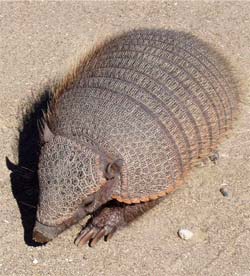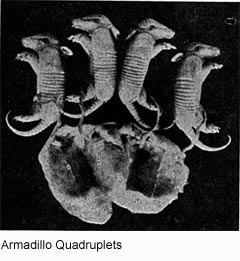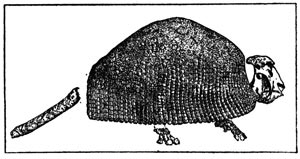
Armadigger, Armadiet: Armadillos are prolific diggers, and many species use their sharp claws to dig for food such as grubs and/or to dig dens. The 9-banded armadillo  prefers to build burrows in moist soil near the creeks, streams, and arroyos near which it generally lives and feeds. prefers to build burrows in moist soil near the creeks, streams, and arroyos near which it generally lives and feeds.
The diet of armadillo species varies, but consists mainly of insects, grubs, and other invertebrates. Some species, however, are almost entirely termite/ant specialists.
Glasses for Armadillos? Armadillos have poor vision but are not blind.
Armadillo Armor: The armor is formed by plates of dermal bone covered in small, overlapping, epidermal scales called "scutes". This armor-like skin would appear to be the main defense of many armadillos, although, in fact, most flee predators by running and/or digging, rather than relying on their armor. Armadillos have short legs but can move quickly. They can also hold their breath and walk on the bottom of a lake or any body of water for 6 mins.
Ball of Armor: Only the South American three-banded armadillos (Tolypeutes) tend to rely heavily on their armor. When threatened by a predator, Tolypeutes species will frequently roll up into a ball. Other armadillo species cannot roll up because they have too many plates to curl. Instead, they will sometimes escape predators by running into thorny brush, relying on their armor to protect them from the thorns. The North American Nine-banded Armadillo tends to jump straight in the air when surprised and consequently often collides with the undercarriage of vehicles that might pass over it

 Quadruplets... Constantly! The Nine-banded Armadillo also serves science through its unusual reproductive system, in which four identical quadruplets (all the same sex) are born in each clutch. Because they are always identical, the group of four young provides a good subject for scientific, behavioral or medical tests that need consistent biological and genetic makeup in the test subjects. This phenomenon of multiple identical birth, called polyembryony, only manifests in the genus Dasypus and not in all armadillos.. Quadruplets... Constantly! The Nine-banded Armadillo also serves science through its unusual reproductive system, in which four identical quadruplets (all the same sex) are born in each clutch. Because they are always identical, the group of four young provides a good subject for scientific, behavioral or medical tests that need consistent biological and genetic makeup in the test subjects. This phenomenon of multiple identical birth, called polyembryony, only manifests in the genus Dasypus and not in all armadillos..

Armadillo Ancestor: Glyptodon (Greek for "grooved or carved tooth") was a relative of the armadillo that lived during the Pleistocene Epoch. It is named for its globe-shaped teeth. Flatter than a Volkswagen Beetle, but about the same general size and weight, the glyptodon is believed to have been a herbivore, grazing on grasses and other plants found near rivers and small bodies of water. A large and heavy mammal, it could probably only have moved one or two miles per hour.

Evolutionary History: Glyptodons are part of the placental group of mammals known as Xenarthra. This order of mammals includes anteaters, tree sloths, extinct ground sloths, and armadillos.
Armadillo Shell-ter: Glyptodons originated in South America and first appeared in the American Southwest after North and South America connected at the Isthmus of Panama, about 2.5 million years ago. They became extinct about 10,000 years ago. The native human population in their range is believed to have hunted them, and used the shells of dead animals as shelters in inclement weather.
Anatomy: Glyptodons were covered by a protective shell composed of more than 1,000 one inch-thick bony plates, called osteoderms or scutes. Each species of glyptodont had its own unique osteoderm pattern and shell type. With this protection, they were armored like turtles, but unlike most turtles, could not withdraw their heads, so they developed a bony cap on the top of their skull. Even the tail of Glyptodon had a ring of bones for protection. Such a massive shell needed considerable support, evidenced by features such as fused vertebrae, short but massive limbs, and a broad shoulder girdle.
Primitive Predators: Predators of the glyptodon could have included the sabre-toothed cat, although this predator would likely have struggled to turn the 1 to 2-ton animal over to reach its unprotected belly
Leprosy in Armadillos? Armadillos are often used in the study of leprosy, since they, along with mangabey monkeys, rabbits, and mice (on their footpads), are among the few known non-human animal species that can contract the disease systemically.  They are particularly susceptible, due to their unusually low body temperature, which is hospitable to the leprosy bacterium (Mycobacterium leprae). They are particularly susceptible, due to their unusually low body temperature, which is hospitable to the leprosy bacterium (Mycobacterium leprae).
Armadillo Trivia: The armadillo was, over some resistance, made the state small mammal of Texas where it is considered a pest, and usually seen flattened on the roadside
In Maine, it is illegal to own an armadillo. Armadillos can be kept as pets, although they require moist ground in which to dig and catch insects. They are difficult to domesticate fully.
A stuffed armadillo plays an important role in John Irving's novel, "A Prayer for Owen Meany."
Because of the weight of its armor, an armadillo will sink in water unless it inflates its stomach with air, which often doubles its size.
A number of towns in Texas hold beauty pageants for armadillos.
Bonobos and armadillos are the only mammals other than humans that engage in intercourse in the missionary position (face-to-face).
German POWs in Texas would often refer to the armadillo as "panzer swine".
Recorded to be the animal with the most dreams in sleep (that is, with the most observed REM sleep).
Surprisingly, armadillos are very agile in the water and have been known to swim for up to two miles without rest.
Armadillo is Spanish for “little armored one.”

All text is available under the terms
of the GNU Free Documentation License
|